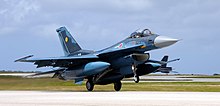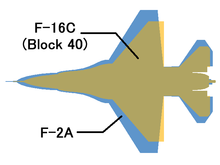Mitsubishi F-2
| Mitsubishi F-2 | |
|---|---|
 F-2 at the JASDF base in Tsuiki |
|
| Type: | Multipurpose fighter |
| Design country: | |
| Manufacturer: | |
| First flight: |
October 7, 1995 |
| Commissioning: |
September 2000 |
| Production time: |
1999 to 2011 |
| Number of pieces: |
98 |
The Mitsubishi F-2 is a Japanese multi-role fighter aircraft based on the US F-16 "Fighting Falcon" .
history
In the mid-1980s, Japan began looking for a successor to their F-1 . After some controversy, it was decided to further develop the F-16. In October 1987 the program known as FS-X was officially started.
Compared to the original F-16 model, the F-2 has been further developed and adapted, so that it is referred to as a separate type of aircraft. The fuselage of the F-2 is longer, the plastic wings are a lot larger and a completely new development. The J / APG-1 multi-purpose radar developed by Mitsubishi Electric is said to have a range of 190 km; the F-2 was the first production fighter in the world to be equipped with a J / APG-1 - AESA radar . The generous use of composite materials made it possible to reduce the size of the radar signature . It was also planned to install canards on the air inlet on the fuselage, but this was ultimately not implemented. The cockpit is equipped with a head-up display , screens and a Lockheed ejection seat . It is controlled via a fly-by-wire system and a HOTAS control. A 1: 1 mock-up was presented in mid-1992 and the first of four prototypes (including two two-seaters) were rolled out in early 1995. The XF-2A (63-0001) made its maiden flight on October 7, 1995 with Yoshiyuki Watanabe at the controls. The second prototype followed on December 13, 1995. During the flight test, problems arose due to flutter when equipped with anti-ship guided weapons and insufficient strength of the wings, which further delayed the program. A single-seat F-2 was the first series-produced aircraft to fly in 1999. The machines were built in two versions: a single-seater (F-2A) and a two-seater (F-2B).
The first series machines were on the third season of the September 2000 Japanese air forces (Japanese Air Self-Defense Force) in Misawa delivered. A total of 180 machines were to be procured (47 of which were of the type F-2B), but due to cost increases and a restricted budget, only 94 machines of both types were ultimately purchased. The F-2 replaces the Mitsubishi F-1 in the role of a fighter-bomber (Battlefield Air Interdiction, Close Air Support, Anti-Surface Warfare) and supports the F-15J Eagle in air defense. During the Tōhoku earthquake in 2011 , 18 machines of the 21st training squadron (including almost all two-seaters), which were in Matsushima at the time of the quake, were damaged or destroyed. 13 of these are being gradually repaired and put back into operation.
On September 27, 2011, the last of the 94 series aircraft was delivered to the Japanese Air Force. Together with the four prototypes, a total of 98 F-2 aircraft were built.
Technical specifications

| Parameter | Data |
|---|---|
| Type | Multipurpose fighter |
| length | 15.52 m |
| span | 11.13 m |
| Wing area | 34.84 m² |
| Wing extension | 3.56 |
| Wing loading |
|
| height | 4.96 m |
| Empty mass | 9,527 kg |
| normal takeoff mass | approx. 18,500 kg |
| Max. Takeoff mass | approx. 22,100 kg |
| g limits | −3 / + 9 g |
| Top speed | Mach 2 (at optimal height) |
| Service ceiling | 17,900 m |
| Use radius | 834 km |
| Transfer range | approx. 3500 km (with external additional tanks) |
| Engine | 1 × General Electric F110 -GE (IHI) -129- turbofan engine |
| Thrust |
|
| Thrust-to-weight ratio |
|
Armament
- Permanently installed on-board cannon
- 1 × 20 mm Gatling - machine gun M61A1 Vulcan
- Air-to-air guided missile
- 4 × Raytheon AIM-7M "Sparrow" - radar-controlled, semi-active for medium distances
- 4 × Mitsubishi AAM-4B - radar-controlled, end-phase guided for medium distances
- 4 × LAU-7 / A start rails for 1 × Raytheon AIM-9L / M "Sidewinder" each - infrared controlled, self-targeting for short distances
- 4 × Mitsubishi AAM-3 '90 -shiki '- infrared controlled, self-aiming for short distances
- Anti-ship missile
- Guided bombs
- 2 × GCS-1 (bomb with IR viewfinder)
- Unguided free-fall bombs
- 4 × BRU-42 TER (Triple Ejection Rack) each with 3 × Mark 82 LDGP (227 kg / 500 lb free-fall bomb)
- 4 × BRU-42 TER (Triple Ejection Rack) each with 3 × JM117 (372 kg / 820 lb free-fall bomb )
- 8 × Aerojet General / Honeywell CBU-87 / B (430 kg cluster bomb with 202 fragment / incendiary bombets each)
- 2 × Mark 83 LDGP (454 kg / 1,000 lb free-fall bomb)
- External container
- 1 × drop-off additional tank on the hull support for 300 US gal. Kerosene
- 2 × drop-off additional tanks on the inner wing support for 600 US gal. Kerosene
See also
Web links
- Mitsubishi Heavy Industries website (in Japanese, English and Chinese)
Individual evidence
- ↑ FliegerRevue March 2012, pp. 24–27, Bridge to the Joint Strike Fighter - Japan completes F-2 fighter fleet

